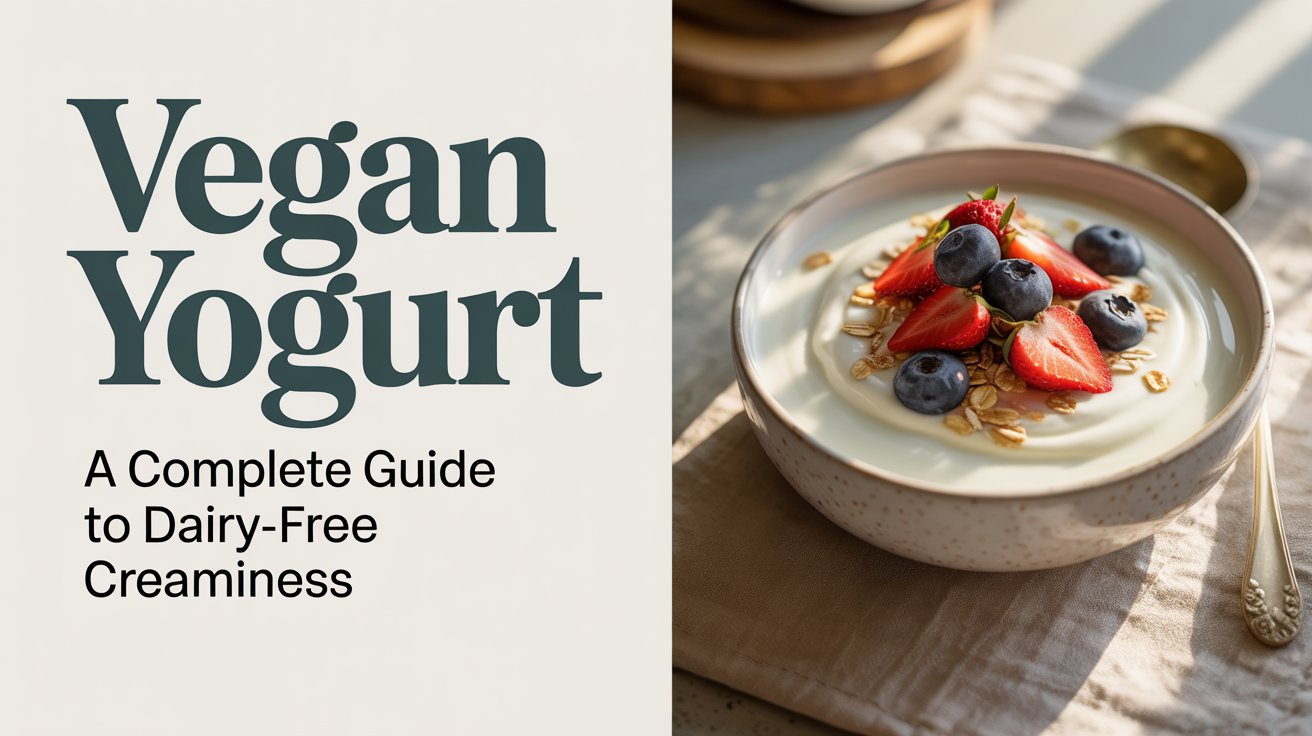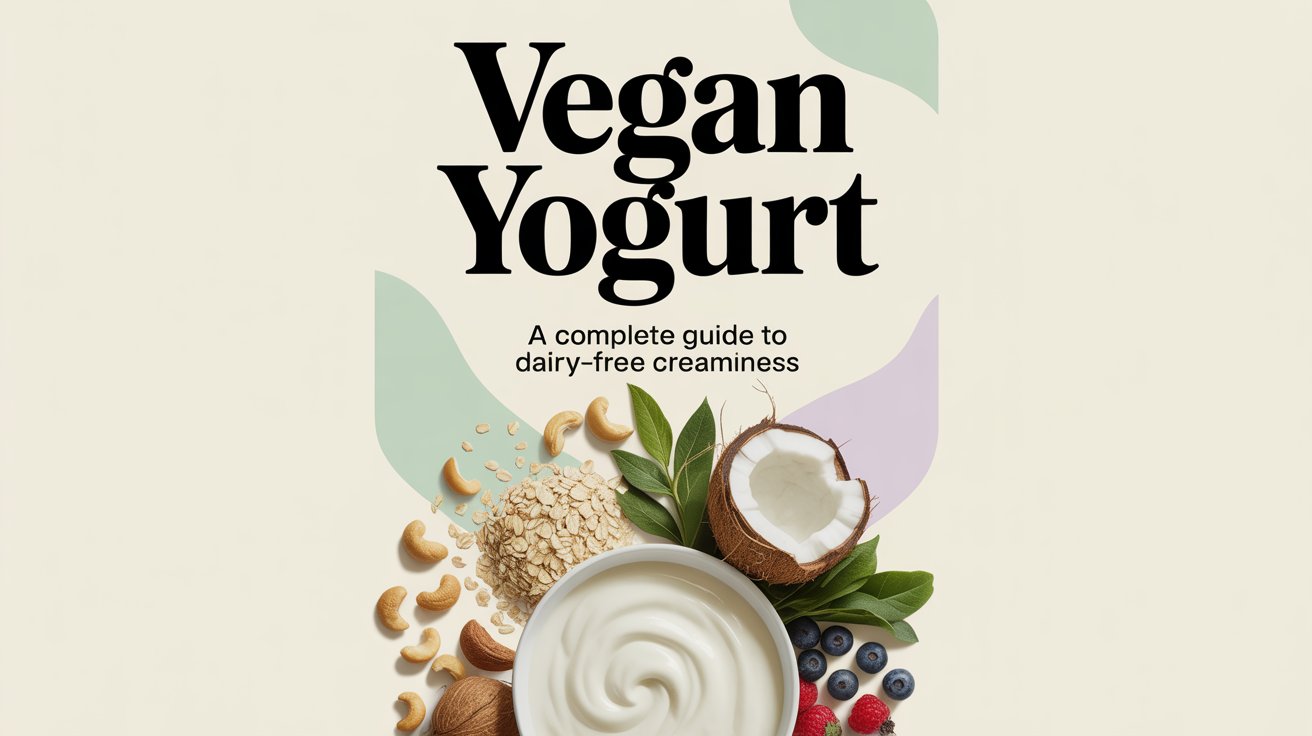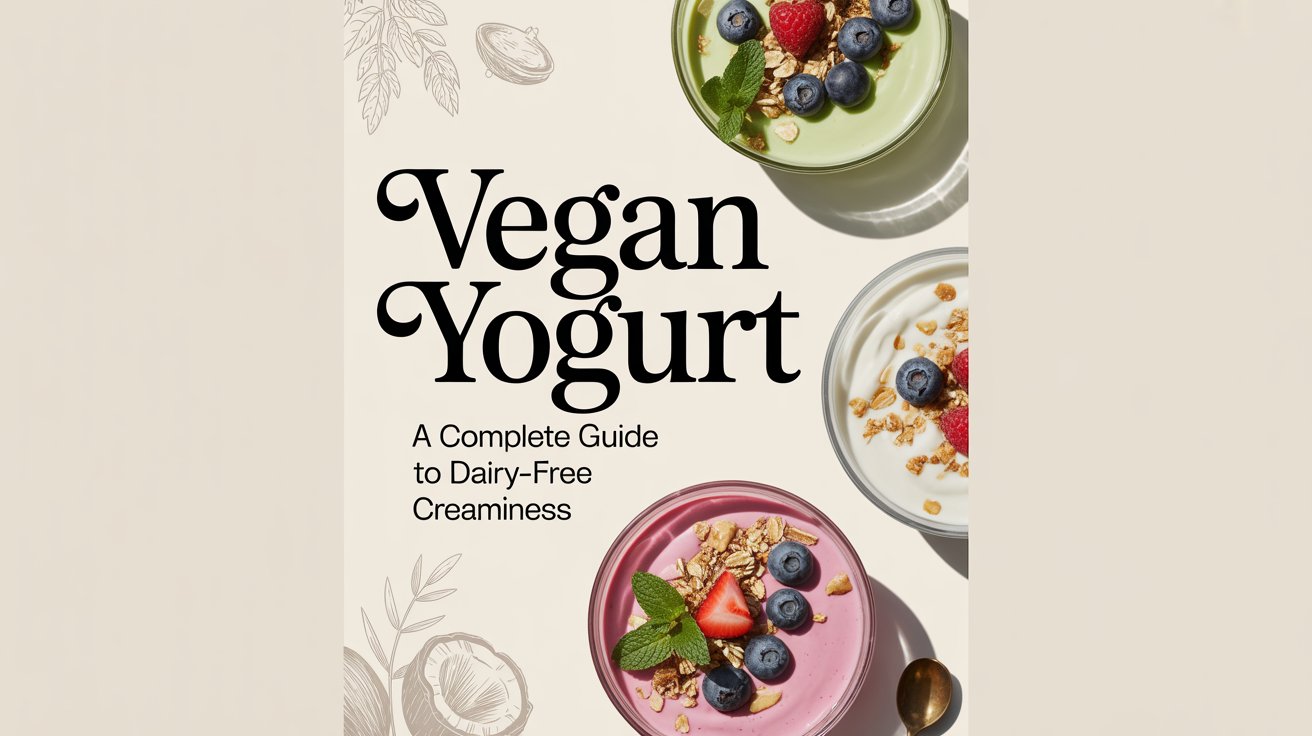Have you ever wondered how something creamy, rich, and tangy like yogurt could exist without a drop of dairy? Welcome to the world of vegan yogurt — a plant-based alternative that’s taking over breakfast tables and dessert bowls everywhere. Whether you’re vegan, lactose-intolerant, or just curious, this guide will walk you through everything you need to know — from how it’s made to why it’s becoming a fridge essential for so many.
Think of vegan yogurt as a canvas of flavors and textures, crafted not from milk but from plants like almonds, coconuts, oats, or soy. It’s a creamy revolution — and once you try it, you might not look back.
What Is Vegan Yogurt?
Vegan yogurt is a dairy-free alternative made from plant-based ingredients instead of cow’s milk. It’s fermented using live cultures, just like traditional yogurt, giving it that familiar tangy flavor and creamy consistency.
Instead of dairy, it uses plant milks like soy, almond, oat, coconut, or cashew. These are blended, thickened, and then fermented to create a yogurt-like product. The result? A smooth, probiotic-rich food that looks and feels like yogurt — minus the lactose or animal products.
How Is Vegan Yogurt Made?
The process of making vegan yogurt is surprisingly similar to dairy yogurt. Here’s a simple breakdown:
-
Base preparation: Start with a plant milk such as almond, soy, or coconut.
-
Thickening: Natural thickeners like tapioca starch, agar-agar, or pectin are added to achieve creaminess.
-
Fermentation: Live bacterial cultures (like Lactobacillus bulgaricus and Streptococcus thermophilus) are introduced to the mixture.
-
Incubation: The mixture is kept warm for several hours, allowing bacteria to ferment the sugars and develop the tangy flavor.
-
Cooling and flavoring: Once thickened, it’s cooled and flavored with fruits, vanilla, or natural sweeteners.
The beauty of vegan yogurt is that it’s alive — literally! Those probiotics help promote gut health, just as they do in traditional yogurt.
Common Plant Bases Used in Vegan Yogurt

Each type of plant-based yogurt has its own flavor and nutritional profile. Let’s explore the most popular ones:
Soy Yogurt
Soy yogurt is one of the oldest and most protein-rich options. It has a neutral taste and a texture close to dairy yogurt.
Coconut Yogurt
Made from coconut milk, this type is rich, thick, and naturally sweet. It’s higher in fat but perfect for desserts or smoothies.
Almond Yogurt
Light, slightly nutty, and lower in calories, almond yogurt is great for those who prefer a mild taste.
Oat Yogurt
Oat yogurt is the newcomer that’s winning hearts for its creamy texture and subtle sweetness. It’s naturally gluten-free (when made from certified oats).
Cashew Yogurt
Smooth and decadent, cashew yogurt feels luxurious and is ideal for creamy dips or desserts.
Nutritional Profile: How Healthy Is It?
Vegan yogurt can be incredibly healthy — but it depends on the brand and ingredients used. Generally, it’s lower in saturated fat and free from cholesterol.
Here’s what makes it nutritionally appealing:
-
Rich in probiotics for better digestion.
-
Lactose-free, perfect for those with intolerance.
-
Plant-based protein (especially in soy and pea-based yogurts).
-
Added vitamins and minerals, such as B12 and calcium, in fortified brands.
However, not all vegan yogurts are created equal. Some contain added sugars or artificial thickeners. Always check the nutrition label to choose wisely.
The Environmental Benefits of Choosing Vegan Yogurt
Switching from dairy to vegan yogurt doesn’t just benefit your health — it helps the planet too.
Producing plant-based yogurt typically requires less water, land, and energy than dairy-based products. Moreover, it reduces greenhouse gas emissions since there’s no involvement of livestock farming.
In simple terms, every spoonful of vegan yogurt is a small step toward sustainability — like planting a seed for a greener planet.
Taste and Texture: How Does It Compare to Dairy Yogurt?

If you’ve ever tasted vegan yogurt, you know it can be surprisingly close to dairy yogurt — sometimes even creamier!
-
Soy and oat yogurts have a smooth, dairy-like texture.
-
Coconut yogurt tends to be thicker and slightly sweet.
-
Almond or cashew versions have a mild nutty undertone.
Manufacturers are constantly improving the fermentation process, so the gap between plant-based and dairy-based yogurts is closing fast.
Think of it like switching from cow’s milk to almond milk — it’s different, but your taste buds quickly adjust.
Best Ways to Enjoy Vegan Yogurt
Vegan yogurt is incredibly versatile. You can enjoy it:
-
Plain, as a quick snack.
-
With granola and fruits, for a wholesome breakfast.
-
As a smoothie base, blending it with berries or bananas.
-
In savory dishes, like sauces or salad dressings.
-
As a dessert topping, instead of whipped cream.
It’s like the Swiss army knife of dairy alternatives — one jar, endless uses.
Homemade Vegan Yogurt: Simple Recipe
Making your own vegan yogurt is easier than you think! Here’s a quick recipe using coconut milk:
Ingredients:
-
2 cans of full-fat coconut milk
-
2 tablespoons of cornstarch or tapioca starch
-
2 tablespoons of plain vegan yogurt (starter culture)
-
1 tablespoon of maple syrup or sugar
Steps:
-
Heat the coconut milk and starch in a saucepan until slightly thickened.
-
Cool it down to warm temperature.
-
Stir in the yogurt starter and sweetener.
-
Pour into jars and incubate at 40°C (104°F) for 8–10 hours.
-
Chill and enjoy!
The result is rich, tangy, and 100% plant-powered.
Popular Vegan Yogurt Brands Around the World
The plant-based yogurt market is booming. Some popular brands include:
-
Silk (USA) – Soy, almond, and oat-based yogurts.
-
Alpro (Europe) – Known for variety and fortification.
-
Cocojune (Global) – Organic coconut-based yogurt with probiotics.
-
So Delicious (USA) – Coconut and cashew blends.
-
Oatly (Sweden) – Creamy oat yogurts that are a hit with coffee lovers.
These brands show how creative plant-based innovation has become — making it easier than ever to find a flavor and texture you love.
Vegan Yogurt in Cooking and Baking

Vegan yogurt is not just for eating plain — it’s a secret ingredient that enhances many dishes.
Use it to:
-
Replace sour cream in dips and sauces.
-
Add moisture and fluffiness to cakes or muffins.
-
Create creamy salad dressings or marinades.
-
Make dairy-free parfaits and puddings.
It’s a versatile substitute that works beautifully in both sweet and savory recipes.
Is Vegan Yogurt Suitable for Everyone?
Generally, yes! Vegan yogurt is suitable for most people, including those with lactose intolerance, milk allergies, or cholesterol concerns.
However, check the label if you have nut or soy allergies, as some versions may not be safe. Always choose fortified products to ensure you’re getting essential nutrients like calcium and vitamin B12.
The Future of Vegan Yogurt
The future looks creamy and bright for vegan yogurt lovers. With rising demand for sustainable, ethical food, manufacturers are experimenting with new bases like hemp, pea, and flaxseed.
Technological advancements in fermentation are also improving flavor and texture. Soon, vegan yogurt might not just rival dairy — it could surpass it.
FAQs
1. Is vegan yogurt healthier than regular yogurt?
It can be, especially if it’s unsweetened and fortified. It’s lower in saturated fats and cholesterol-free, but always check for added sugars.
2. Can vegan yogurt provide probiotics like dairy yogurt?
Yes! Most vegan yogurts contain live active cultures that support gut health, just like traditional yogurt.
3. How long does vegan yogurt last in the fridge?
Typically, it lasts about 7–10 days when unopened. Once opened, consume it within 5 days for best freshness.
4. Can I use vegan yogurt in baking?
Absolutely! It adds moisture and lightness to cakes, muffins, and pancakes. Use it as a one-to-one substitute for dairy yogurt.
5. What’s the best plant milk for homemade vegan yogurt?
Soy and coconut milks give the creamiest results, but you can experiment with oat or cashew milk for different textures and flavors.
Conclusion
Vegan yogurt isn’t just a trend — it’s a transformation. From its nutritional benefits to environmental advantages, it’s redefining what yogurt can be. Whether you enjoy it with granola, use it in recipes, or make your own at home, vegan yogurt proves that you don’t need dairy to enjoy delicious creaminess.
So next time you open your fridge, maybe that little tub of plant-based goodness will be waiting to greet you — tangy, smooth, and utterly satisfying.










